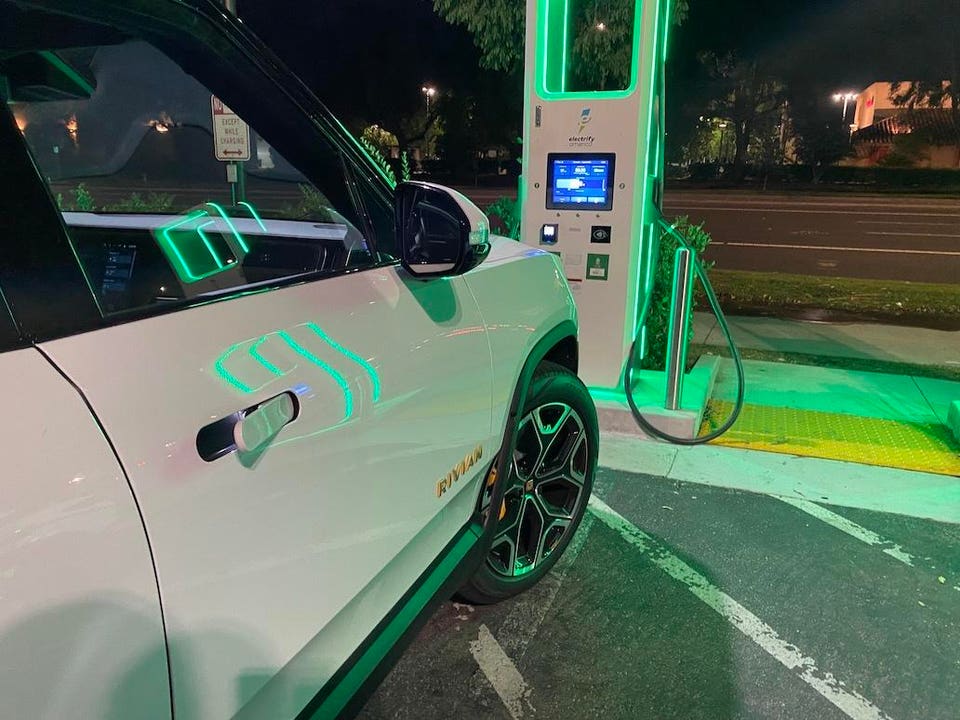Forbes Innovation Consumer Tech Electrify America Explains Cause Of Those Vexing EV Charging Problems Brooke Crothers Contributor Opinions expressed by Forbes Contributors are their own. I cover and review electric vehicles and consumer tech. Following Oct 15, 2023, 03:54pm EDT | Press play to listen to this article! Got it! Share to Facebook Share to Twitter Share to Linkedin When charging a Rivian R1S at an Electrify America station in Los Angeles, I got exceedingly slow .
. . [+] charging rates.
Credit: Brooke Crothers Does this sound familiar: you love your EV but hate charging on the road. This is an especially exasperating problem for non-Tesla owners. And a daunting challenge for the largest non-Tesla EV charging network in the U.
S. , Electrify America (EA). I recently had a conversation with Anthony Lampkin, VP of Operations at Electrify America, about the causes and challenges.
As a foreword — and as I explained to Mr. Lampkin — I have been driving EVs for 10 years and have been using Electrify America ever since it installed charging stations near me in Los Angeles in early 2020. The cause: components The most persistent and pesky problem is chargers that don’t work — either being completely inoperable or not delivering the charge fast enough.
It’s widely believed that a lack of technicians is the root cause, Lampkin said. But it’s usually a component problem, he said. “There’s a lot of different components in the system to deliver the power safely,” according to Lampkin.
“Weather affects components. Hot day, cold day. A lot of different things are involved in the power and delivery pathway.
And not all the time do those things go right. ” EA is now on its fourth generation of chargers and the older chargers — which many charging sites still have — don’t hold up under heavy user loads, Lampkin said. MORE FOR YOU Audi And Volvo Group Are Tackling Sustainability Beyond Electric Vehicles For example, a problem I was having with a charger at an EA station in Valencia, California (a neighborhood within the town of Santa Clarita in Los Angeles County) was due to a component, Lampkin said.
In that case, I was getting slow charging speeds (about 30 kilowatts peak) well below what my Chevy Bolt can achieve at peak (about 50 kW) when the battery capacity is low. And I had the same problem at the same charging station with a Rivian R1S I was driving a few weeks earlier. Instead of getting typical charging speeds of 100 kW or above with the Rivian, I was getting only 40 kW.
A component in the power cabinet was the culprit, Lampkin said. It was preventing the system from delivering full charging speeds. Electrify America had to send a technician to the site and replace that part.
But I should add that I suspect there was something else going on at the Valencia site in addition to the component problem. At other times, other chargers would show a warning on the display stating full charging speeds were not possible. These messages would come and go.
The larger point is that these kinds of issues (including chargers that are unavailable/inoperable) can be repeated at multiple EA charging sites across the U. S. every day.
Especially as newer EVs, such as Rivian vehicles and the Porsche Taycan, demand much higher charging speeds than EVs on the market only a few years ago. ( It should be noted that EV owners — especially those driving an EV for the first time — sometimes blame EA for problems on the driver’s end or because they don’t understand how EV charging works. For example, a Chevy Bolt owner may complain to EA that they’re using a “Hyper-Fast” 350kW charger and getting only 50kW.
In fact, the Bolt cannot charge at rates higher than about 50kW. This applies to other EVs too that have upper limits on charging rates . ) The challenge: surge in demand “Utilization increases have been tremendous for us,” Lampkin told me.
“We had 5. 2 million sessions last year, up from 1. 4 million in 2021.
” “There is exceptionally high utilization especially in places like California. And there are things like heat that contribute to premature failures,” he said. Getting the necessary parts is both the challenge as well as the cause of issues, as described above.
“We. . .
need the parts. If you look at the history of scaling up this new technology in the market. First, you have to get access to the equipment.
You have to buy as much as you can as fast as you can and certify. You need to scale it up. You need to make sure you have the technicians available.
Then make sure the technicians are all trained. ” “Now we’re at the point that we need to make sure there are enough parts available. And that those parts are properly tested, certified, and available to dispatch in quantities to ensure that we’re keeping the equipment at its optimal level,” he said.
Follow me on Twitter . Brooke Crothers Editorial Standards Print Reprints & Permissions.
From: forbes
URL: https://www.forbes.com/sites/brookecrothers/2023/10/15/electrify-america-explains-cause-of-those-vexing-ev-charging-problems/



